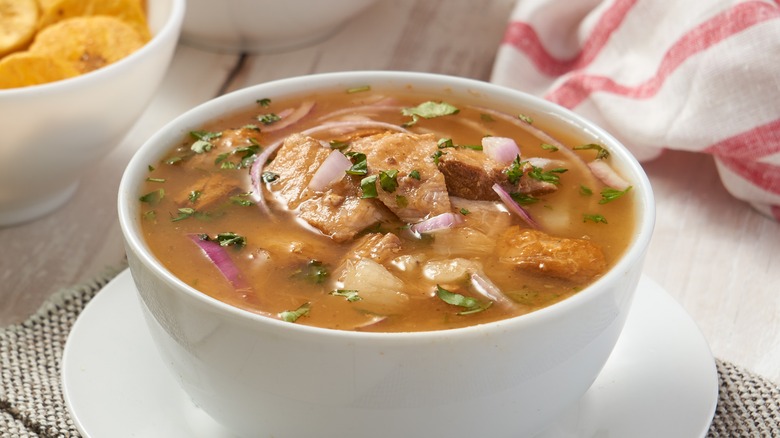The Most Unusual Dish The Queen Was Served During Her Reign
For the average person, it's hard not to imagine that Queen Elizabeth II spends her days dining on every decadent, expensive meal her heart desires.
And while that may be true most of the time, as evidenced by her love for desserts and venison, fans are fully aware that feasting with the royal family has its own special set of rules. For example, Express reports that any meat served to the monarch during banquets must be sliced by a grand carver. And fruit, including bananas, must be eaten with a knife and fork (per Today).
And those are just the rules that apply to everyone. According to The Telegraph, the Queen has a laundry list of things she won't eat herself, including rare meat, square sandwiches, out-of-season fruit, and starches like pasta or potatoes — unless it's a special occasion.
Occasionally, however, there have been times throughout her 70-year reign when what her Majesty was eating for dinner was not completely under her control. Namely, during her tours in different parts of the world, where eating the local cuisine likely functions as a way of showing respect to the country's culture.
And as someone who has visited over 100 countries, the Queen has been served a host of food you probably wouldn't ever find on a British dining table. But none may be as unforgettable as the dinner she received during one visit to Belize many years ago.
The Queen was served a rat stew in Belize
"Ratatouille" movie fans might want to stop reading now. According to Atlas Obscura, during a 1985 tour to Belize, Queen Elizabeth II was served stewed gibnut, a type of "bush" rat native to the country.
As the publication points out, rat meat was a peculiar choice — though not necessarily because it's a rodent. More that game meat was long considered a meal for the working class — far from anything you'd expect someone to serve a member of the royal family. For centuries, the chipmunk-like rodent was a staple protein in farming communities because it was easy to hunt. However, as the BBC points out, this is now the case with most common food that become delicacies, as scarcity (mostly brought on by the destruction of their habitat) makes the meat sought-after, which may be why it was believed to be fit for a queen.
Although her Majesty never publicly expressed an opinion of the rat stew, one can speculate. According to royal chef Graham Newbould, she "pushed her food from the plate that night," (via YouTube). In any case, the dinner left an impression on Belizeans. Since the visit, locals have referred to gibnut as the "royal rat." Now that's what you call rats to riches!

